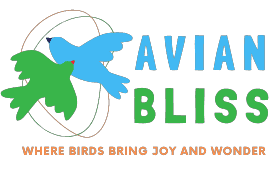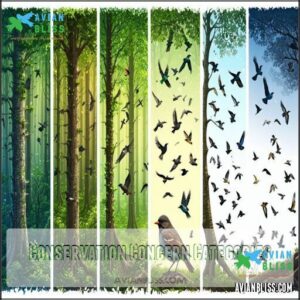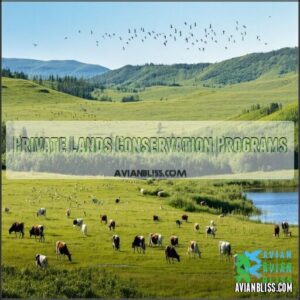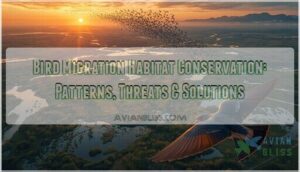This site is supported by our readers. We may earn a commission, at no cost to you, if you purchase through links.
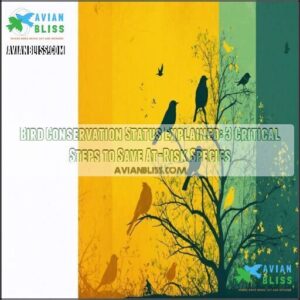
It’s a classification system that shows how close a bird species is to extinction. Organizations like the IUCN use criteria such as population size, distribution range, and decline rate to assign categories from "Least Concern" to "Critically Endangered."
You’ll find these statuses used by scientists and conservationists to prioritize protection efforts where they’re needed most. Think of it as a bird’s health chart—the worse the diagnosis, the more urgent the treatment.
Understanding these classifications helps identify which species need your immediate attention before they become mere memories in field guides.
Table Of Contents
- Key Takeaways
- Bird Conservation Status
- Bird Species Classification
- Conservation Efforts and Strategies
- Economic and Societal Benefits
- Conservation Status and Action
- Frequently Asked Questions (FAQs)
- Why is bird conservation important?
- Do birds need conservation attention?
- Can a steep decline in bird population be reversed?
- Are bird populations declining?
- What is a bird conservation list?
- Does conservation work in halting bird declines?
- What are the 7 levels of conservation status?
- What is the #1 most endangered bird?
- How is conservation status determined?
- Why are songbirds declining?
- Conclusion
Key Takeaways
- You’ll understand bird conservation status as a system that ranks species from "Least Concern" to "Critically Endangered," helping prioritize protection efforts based on extinction risk.
- Birds face major threats like habitat loss, climate change, and invasive species, making conservation actions like habitat restoration crucial for their survival.
- Supporting conservation initiatives, from private land programs to collaborative partnerships, directly helps protect ecosystems and bird populations.
- Bird conservation doesn’t just save species—it boosts the economy through birdwatching, creates jobs, and improves mental well-being by connecting people with nature.
Bird Conservation Status
You’ll find bird conservation status acts as a critical early warning system, categorizing species from "Least Concern" to "Endangered" based on population trends and extinction risk.
When you understand these classifications, you’re better equipped to support targeted conservation efforts that can prevent the continued loss of the 3 billion birds North America has already lost since 1970, which is a critical aspect of bird conservation and highlights the need for urgent action to protect species from becoming "Least Concern".
Definition and Importance
Standing at the crossroads of science and stewardship, bird conservation status defines how close a species is to extinction and why protecting them matters.
Bird conservation status importance extends beyond mere classification:
- Ecosystem Health: Birds regulate pest populations and disperse seeds
- Economic Impact: Birdwatching generates billions in tourism revenue
- Conservation Urgency: Status levels trigger specific protection measures
- Ethical Considerations: We’ve a moral obligation to prevent extinctions
Understanding these status significance indicators helps prioritize conservation efforts where they’re most needed, ensuring bird populations remain vibrant for future generations to enjoy.
Threats to Bird Populations
After understanding the importance of conservation status, you’ll want to know what’s causing birds to disappear.
Four major threats drive population decline: habitat destruction (from agriculture and development), climate change impacts, invasive species competition, and pollution effects like pesticides.
Additionally, predation pressure from domestic cats and collisions with buildings kill millions of birds annually.
These combined pressures explain why over 3 billion North American birds have vanished since 1970.
Many endangered bird species face multiple threats simultaneously, making recovery challenging.
The acceleration of habitat loss leaves threatened birds with fewer places to nest, feed, and raise young.
Role of Habitat Conservation
Beyond threats lies the solution: habitat conservation.
While birds face mounting pressures, protecting their homes offers hope.
Your role in habitat conservation matters through these key actions:
- Supporting protected areas that maintain habitat connectivity
- Restoring degraded ecosystems to improve climate resilience
- Creating urban habitats like backyard bird sanctuaries
- Advocating for policies that prevent habitat loss
Every acre preserved strengthens ecosystem services that both birds and humans depend on.
Bird Species Classification
You’ll find that bird species classification forms the backbone of effective conservation efforts, organizing at-risk birds into categories based on population trends and threat levels.
When you understand these classifications, from Least Concern to Critically Endangered, you can better prioritize which feathered friends need our immediate attention and resources.
Endangered and Vulnerable Species
You’ll find Allen’s Hummingbird and Saltmarsh Sparrow among America’s most endangered bird species, facing extinction without immediate intervention.
The 2025 State of Birds Report identifies 42 Red-Alert Species at perilously low populations, while 112 Tipping Point species have lost over 50% of their numbers since 1970.
Habitat loss remains the primary driver of avian extinction risk, though conservation funding and breeding programs offer hope for population recovery of these vulnerable birds.
Conservation Concern Categories
Many birds fall into various conservation concern categories before reaching endangered status.
These classifications—from "Least Concern" to "Red-Alert Species"—help prioritize conservation efforts based on population trends and habitat loss risk assessment.
The 2025 State of Birds Report identifies 112 Tipping Point species that have lost over 50% of their populations and 42 Red-Alert species facing perilously low numbers.
Conservation prioritization uses these categories to develop targeted policy implications before species reach critical thresholds.
IUCN Red List Criteria
Five key criteria determine a bird’s conservation status on the IUCN Red List, acting as an early warning system for endangered bird species.
You’ll recognize these scientific indicators in action:
- Population Reduction: Rate at which bird numbers are declining
- Geographic Range: Available habitat size and fragmentation
- Population Size: Total individuals remaining in the wild
- Quantitative Analysis: Mathematical models predicting Extinction Risk
"Data Deficient" species lack sufficient information, making urgent research critical before habitat destruction accelerates their decline.
Conservation efforts are increasing, with stable bird populations showing positive trends.
Conservation Efforts and Strategies
You’ll find that effective bird conservation strategies combine science-based planning with collaborative action across multiple sectors, from habitat restoration to private lands programs.
By supporting these proven approaches, you’re helping protect not just birds but also the ecosystems that sustain both wildlife and humans, through collaborative action.
Habitat Restoration and Preservation
Through strategic habitat restoration, you’re creating essential lifelines for endangered birds.
When you tackle habitat preservation, you’re not just saving land—you’re rebuilding entire ecosystems. Native plantings and invasive control work together to transform degraded areas into thriving bird sanctuaries.
You can find necessary habitat restoration products for these efforts.
Protected areas dramatically increase climate resilience, while habitat connectivity allows species to migrate between safe zones.
The heartbreaking reality of habitat loss requires immediate action—your efforts in conservation directly impact bird conservation status, turning declining populations into success stories.
Private Lands Conservation Programs
Nearly 60% of U.S. land is privately owned, making private lands conservation essential for bird survival.
Private lands support over two-thirds of endangered species.
Farm Bill programs provide $6 billion annually to protect critical habitats while supporting landowners.
- Ranching partnerships create wildlife-friendly grazing systems
- Coastal restoration projects rebuild declining shorebird habitats
- Forest renewal initiatives protect woodland species
- Habitat incentives compensate landowners for conservation practices
- Sustainable agriculture programs balance production with bird protection
Conservation easements offer permanent protection, with land trusts already safeguarding 60 million acres of important habitat. Consider supporting private lands initiatives to further these efforts and support wildlife-friendly practices for bird survival.
Collaborative Conservation Initiatives
While private land programs create individual impact, collaborative conservation initiatives build powerful networks for bird protection.
Cross-sector partnerships multiply what’s possible when organizations share resources. You’ll find successful models everywhere:
- Joint Ventures like AMJV connecting forest landowners to protect Cerulean Warblers
- Diverse funding mechanisms blending public, private, and corporate investments
- Community engagement programs bringing citizens into bird monitoring efforts
- Policy advocacy coalitions amplifying conservation voices at local and national levels
These collaborative conservation efforts don’t just save birds—they build communities committed to lasting change. Habitat restoration efforts have saved species from extinction.
Economic and Societal Benefits
You’ll discover that protecting birds creates a ripple effect of benefits, from supporting the $279 billion birdwatching economy that employs 1.4 million Americans.
When you safeguard bird habitats, you’re also preserving the essential ecosystem services that sustain communities across the nation, which can improve your mental well-being through regular encounters with nature.
Birdwatching and Ecotourism
Passionate birdwatchers pump a staggering $279 billion into the American economy annually as they travel to glimpse rare species.
This economic impact transforms conservation into a powerful financial engine, with ecotourism creating sustainable revenue streams for communities near birding hotspots.
Ethical birding practices guarantee these benefits continue while protecting the very birds that draw visitors.
Community engagement through accessible birding opportunities connects diverse groups to conservation funding initiatives, strengthening bird protection efforts nationwide.
Job Creation and Income Generation
While you’re tracking rare birds, you’re also tracking economic growth. Bird conservation generates substantial economic output across America, supporting rural development through sustainable economies.
When you participate in birding activities, you help power a $279 billion industry that sustains 1.4 million jobs nationwide. One can also assist with monitoring bird populations as a volunteer.
Five ways conservation employment boosts local economies:
- Wildlife guide positions
- Habitat restoration projects
- Ecotourism revenue in rural communities
- Conservation research funding
- Bird-friendly product development
Mental Health and Well-being
Beyond just creating jobs, bird conservation directly impacts your psychological wellbeing.
Research shows that birdwatching delivers significant mental health benefits, acting as nature’s therapy for millions of Americans. When you spend time observing birds, your body responds with measurable reductions in stress hormones and anxiety.
Urban birding provides accessible mental resilience building, even in city environments. Conservation psychology studies confirm that regular bird encounters decrease depressive symptoms and improve overall mood.
The simple act of hearing birdsong in the morning can trigger positive emotional responses, creating a sense of connection to the natural world. This relationship explains why birdwatching benefits extend beyond recreational enjoyment to fundamentally support psychological health and emotional balance.
Conservation Status and Action
You’ll need to understand bird conservation status categories to effectively protect species at risk, from "Least Concern" to "Critically Endangered" classifications established by conservation authorities.
Once you’ve identified vulnerable species, you can implement targeted conservation measures that address specific threats while monitoring outcomes to adapt strategies based on scientific evidence.
Identifying Species at Risk
Identifying at-risk bird species hinges on thorough Population Monitoring.
Scientists employ Risk Assessment methods to track declining populations and evaluate Climate Impacts and Habitat Loss.
The 42 RedAlert Species (like Allen’s Hummingbird) receive immediate Conservation Prioritization, while 112 Tipping Point species approaching critical thresholds demand vigilant attention.
Understanding bird conservation status helps you recognize which species face extinction—knowledge that’s essential for directing limited resources where they’ll make the biggest difference.
Implementing Effective Conservation Measures
Now that we’ve identified species at risk, effective conservation action requires strategic implementation.
To save bird populations, you’ll need to employ these proven methods:
- Establish protected areas that serve as refuges against habitat destruction
- Create conservation easements with landowners for long-term habitat protection
- Implement zoning regulations that safeguard critical ecosystems
- Engage stakeholders at every level to guarantee community support
Policy implementation and funding mechanisms are the backbone of successful conservation efforts, turning science into meaningful habitat restoration. Strategic planning should also include protected area products to enhance conservation efforts, ensuring a long-term approach to conservation.
Monitoring and Evaluating Conservation Success
Now that you’ve implemented conservation strategies, you’ll need to measure their impact.
Monitoring programs act as your conservation status report card – revealing if bird populations are truly recovering. Through data analysis and established reporting standards, you can track long-term impacts on vulnerable species.
When success metrics indicate a strategy isn’t working, adaptive management allows you to pivot quickly.
Remember, evaluating conservation success isn’t just about counting birds – it’s about ensuring your efforts create lasting positive change for bird conservation status.
To enhance these strategies, consider how regenerative agriculture efforts can promote bird-friendly farming.
Frequently Asked Questions (FAQs)
Why is bird conservation important?
Bird conservation safeguards ecological balance, protects $279 billion in economic activity, and preserves nature for future generations.
You’re supporting biodiversity when you help birds thrive, which ultimately guarantees your own wellbeing too.
Do birds need conservation attention?
Yes, birds urgently need conservation attention. With over 3 billion birds lost since 1970 and 229 species requiring immediate action, your support helps protect these essential indicators of environmental health.
Can a steep decline in bird population be reversed?
Like a garden springing back after drought, yes! You can reverse bird population declines through strategic conservation, habitat restoration, and policy implementation.
Evidence shows when we take concerted action, bird numbers can rebound effectively, and this is a key point to consider for strategic conservation.
Are bird populations declining?
Bird populations are absolutely declining, with over one-third of U.S. species at risk.
Habitat loss, climate change, and environmental stressors are major culprits.
Reversing this trend demands urgent conservation efforts and smarter policies to protect ecosystems.
What is a bird conservation list?
Over 3 billion birds vanished since 1970—that’s alarming, right?
A bird conservation list ranks species by risk, guiding efforts to protect them before they’re endangered.
It’s like a safety net for nature’s feathered friends.
Does conservation work in halting bird declines?
Conservation absolutely works when you back it with science, funding, and collaboration.
Success stories, like waterfowl recovery through wetland protection, prove that targeted efforts can reverse declines and safeguard habitats, benefiting both birds and people alike, which demonstrates that conservation works.
What are the 7 levels of conservation status?
Ever wonder how scientists rank species’ survival chances?
There are seven levels: Least Concern, Near Threatened, Vulnerable, Endangered, Critically Endangered, Extinct in the Wild, and Extinct.
Each reflects population trends and threats.
What is the #1 most endangered bird?
The ʻAkikiki, a critically endangered honeycreeper from Kauaʻi, faces imminent extinction due to habitat loss and invasive species.
With fewer than 50 individuals left, it urgently needs conservation efforts to survive.
How is conservation status determined?
You determine conservation status by analyzing population trends, habitat health, and threats like climate change or predation.
Scientists use data-driven criteria, such as the IUCN Red List, to categorize species from Least Concern to Endangered.
Why are songbirds declining?
Songbirds are declining due to habitat loss, pesticide use, climate change, and invasive species.
Urban sprawl and agricultural expansion reduce nesting areas, while extreme weather disrupts migration and breeding.
It’s like pulling threads from nature’s tapestry.
Conclusion
Saving birds isn’t just about protecting feathers; it’s about preserving ecosystems that sustain life.
By understanding bird conservation status explained through tools like the IUCN Red List, you can pinpoint species needing urgent help.
Support habitat restoration, join local conservation programs, or advocate for stronger protections. Small actions ripple into big impacts, ensuring future generations enjoy the beauty and benefits birds bring.
So, roll up your sleeves—every effort counts in this essential mission.
